Critical Evaluation: Leadership in Contemporary Organizations Essay
VerifiedAdded on 2021/04/17
|10
|2162
|76
Essay
AI Summary
This essay provides a critical evaluation of the charismatic component of transformational leadership within the context of contemporary organizational challenges. It begins by defining contemporary leadership and exploring the two main theories: charismatic and transformational leadership. The essay then delves into the four constituents of transformational leadership: idealized influence, individualized consideration, inspirational motivation, and intellectual stimulation, highlighting the charismatic aspects of idealized influence and inspirational motivation. It examines the characteristics of charismatic leaders, their similarities with transformational leaders, and potential risks associated with charismatic leadership, such as excessive optimism and denial of failures. Furthermore, the essay discusses the Leader-Member Exchange (LMX) theory and the impact of narcissistic leadership. It identifies contemporary organizational challenges, including diversity, outsourcing, innovation, cultural differences, and recruitment. The essay concludes that the charismatic component of transformational leadership positively contributes to mitigating organizational challenges by fostering a positive workplace environment, reducing cultural differences, and guiding practical initiatives. The essay references several academic sources to support its arguments, emphasizing the importance of transformational leadership in achieving organizational success.

Running head: LEADERSHIP IN CONTEMPORARY ORGANIZATIONS
LEADERSHIP IN CONTEMPORARY ORGANIZATIONS
Name of the Student
Name of the University
Author’s Note
LEADERSHIP IN CONTEMPORARY ORGANIZATIONS
Name of the Student
Name of the University
Author’s Note
Paraphrase This Document
Need a fresh take? Get an instant paraphrase of this document with our AI Paraphraser
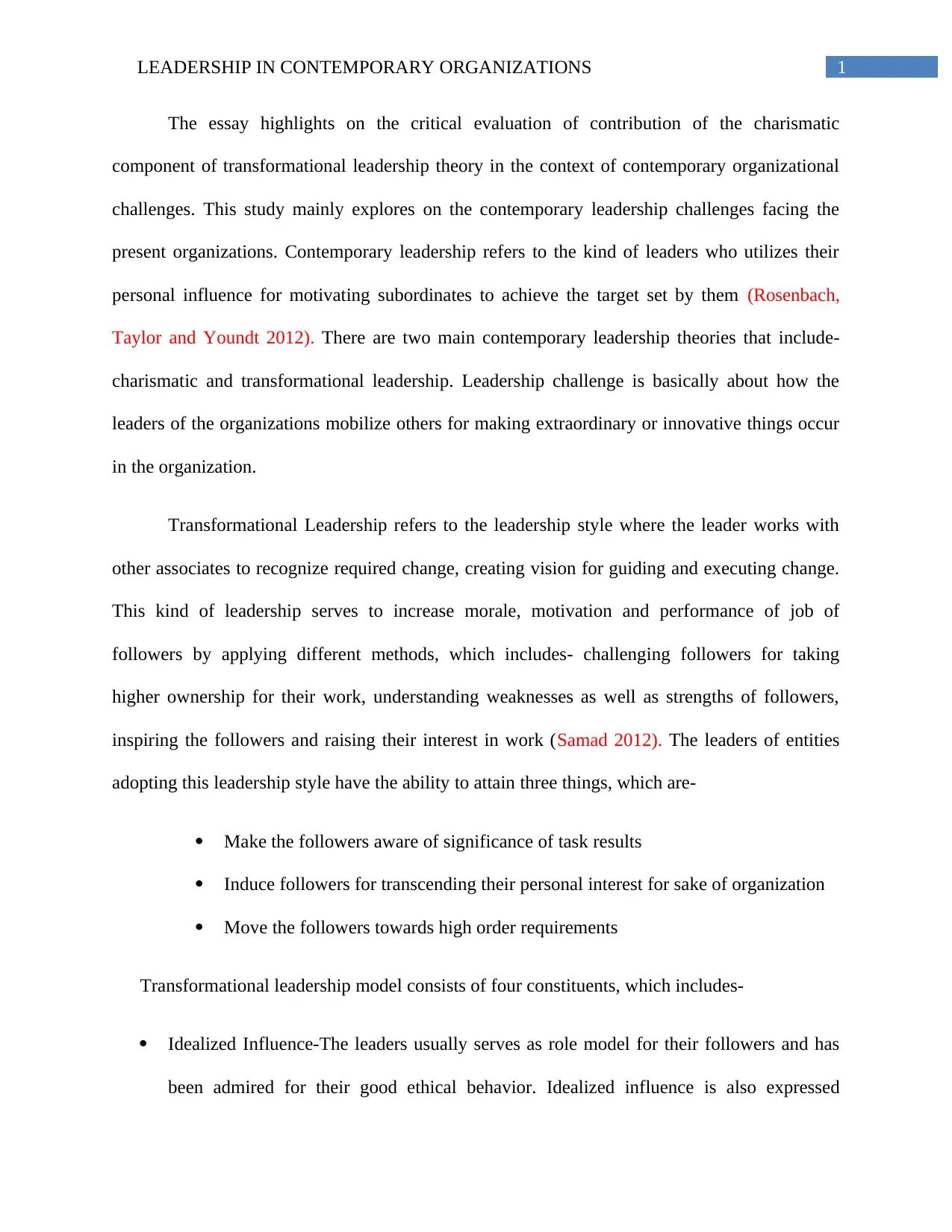
1LEADERSHIP IN CONTEMPORARY ORGANIZATIONS
The essay highlights on the critical evaluation of contribution of the charismatic
component of transformational leadership theory in the context of contemporary organizational
challenges. This study mainly explores on the contemporary leadership challenges facing the
present organizations. Contemporary leadership refers to the kind of leaders who utilizes their
personal influence for motivating subordinates to achieve the target set by them (Rosenbach,
Taylor and Youndt 2012). There are two main contemporary leadership theories that include-
charismatic and transformational leadership. Leadership challenge is basically about how the
leaders of the organizations mobilize others for making extraordinary or innovative things occur
in the organization.
Transformational Leadership refers to the leadership style where the leader works with
other associates to recognize required change, creating vision for guiding and executing change.
This kind of leadership serves to increase morale, motivation and performance of job of
followers by applying different methods, which includes- challenging followers for taking
higher ownership for their work, understanding weaknesses as well as strengths of followers,
inspiring the followers and raising their interest in work (Samad 2012). The leaders of entities
adopting this leadership style have the ability to attain three things, which are-
Make the followers aware of significance of task results
Induce followers for transcending their personal interest for sake of organization
Move the followers towards high order requirements
Transformational leadership model consists of four constituents, which includes-
Idealized Influence-The leaders usually serves as role model for their followers and has
been admired for their good ethical behavior. Idealized influence is also expressed
The essay highlights on the critical evaluation of contribution of the charismatic
component of transformational leadership theory in the context of contemporary organizational
challenges. This study mainly explores on the contemporary leadership challenges facing the
present organizations. Contemporary leadership refers to the kind of leaders who utilizes their
personal influence for motivating subordinates to achieve the target set by them (Rosenbach,
Taylor and Youndt 2012). There are two main contemporary leadership theories that include-
charismatic and transformational leadership. Leadership challenge is basically about how the
leaders of the organizations mobilize others for making extraordinary or innovative things occur
in the organization.
Transformational Leadership refers to the leadership style where the leader works with
other associates to recognize required change, creating vision for guiding and executing change.
This kind of leadership serves to increase morale, motivation and performance of job of
followers by applying different methods, which includes- challenging followers for taking
higher ownership for their work, understanding weaknesses as well as strengths of followers,
inspiring the followers and raising their interest in work (Samad 2012). The leaders of entities
adopting this leadership style have the ability to attain three things, which are-
Make the followers aware of significance of task results
Induce followers for transcending their personal interest for sake of organization
Move the followers towards high order requirements
Transformational leadership model consists of four constituents, which includes-
Idealized Influence-The leaders usually serves as role model for their followers and has
been admired for their good ethical behavior. Idealized influence is also expressed

2LEADERSHIP IN CONTEMPORARY ORGANIZATIONS
through the willingness of transformational leaders to take risk, follow core values and
convictions.
Individualized consideration-This signifies the extent to which leaders attends to the
feelings and requirements of followers. The leader also provides empathy as well as
support and keeps challenges before their followers (Hughes 2014). This attention to
followers acts as vital element for bringing out their best effort. In addition,
transformational leaders also give opportunities to the team members and help them grow
in better way.
Inspirational Motivation- This indicate the extent to which leaders articulates vision,
which is appealing as well as inspiring to their followers. The leaders also challenge the
followers and communicate optimism with them for future target. This feature of
transformational leadership needs good communication skills of the leaders since it
requires them to communicate messages with much precision.
Intellectual Simulation-This signifies the extent to which leaders takes several risks and
solicits the ideas of followers. Besides this, they also stimulate and motivate creativity in
them. However, the vision that these leaders convey facilitates their followers succeeds in
achieving the target.
The two elements of transformational leadership including idealized influence and
inspirational motivation constitute the charisma of transformational leaders. Charisma generally
means compelling attractiveness that helps to inspiring devotion in other individuals (Avolio,
and Yammarino 2013). It fits in describing specific kind of leader who applies value- based and
emotion in their leadership style. It is the procedure that interfaces between features of the
through the willingness of transformational leaders to take risk, follow core values and
convictions.
Individualized consideration-This signifies the extent to which leaders attends to the
feelings and requirements of followers. The leader also provides empathy as well as
support and keeps challenges before their followers (Hughes 2014). This attention to
followers acts as vital element for bringing out their best effort. In addition,
transformational leaders also give opportunities to the team members and help them grow
in better way.
Inspirational Motivation- This indicate the extent to which leaders articulates vision,
which is appealing as well as inspiring to their followers. The leaders also challenge the
followers and communicate optimism with them for future target. This feature of
transformational leadership needs good communication skills of the leaders since it
requires them to communicate messages with much precision.
Intellectual Simulation-This signifies the extent to which leaders takes several risks and
solicits the ideas of followers. Besides this, they also stimulate and motivate creativity in
them. However, the vision that these leaders convey facilitates their followers succeeds in
achieving the target.
The two elements of transformational leadership including idealized influence and
inspirational motivation constitute the charisma of transformational leaders. Charisma generally
means compelling attractiveness that helps to inspiring devotion in other individuals (Avolio,
and Yammarino 2013). It fits in describing specific kind of leader who applies value- based and
emotion in their leadership style. It is the procedure that interfaces between features of the
⊘ This is a preview!⊘
Do you want full access?
Subscribe today to unlock all pages.

Trusted by 1+ million students worldwide
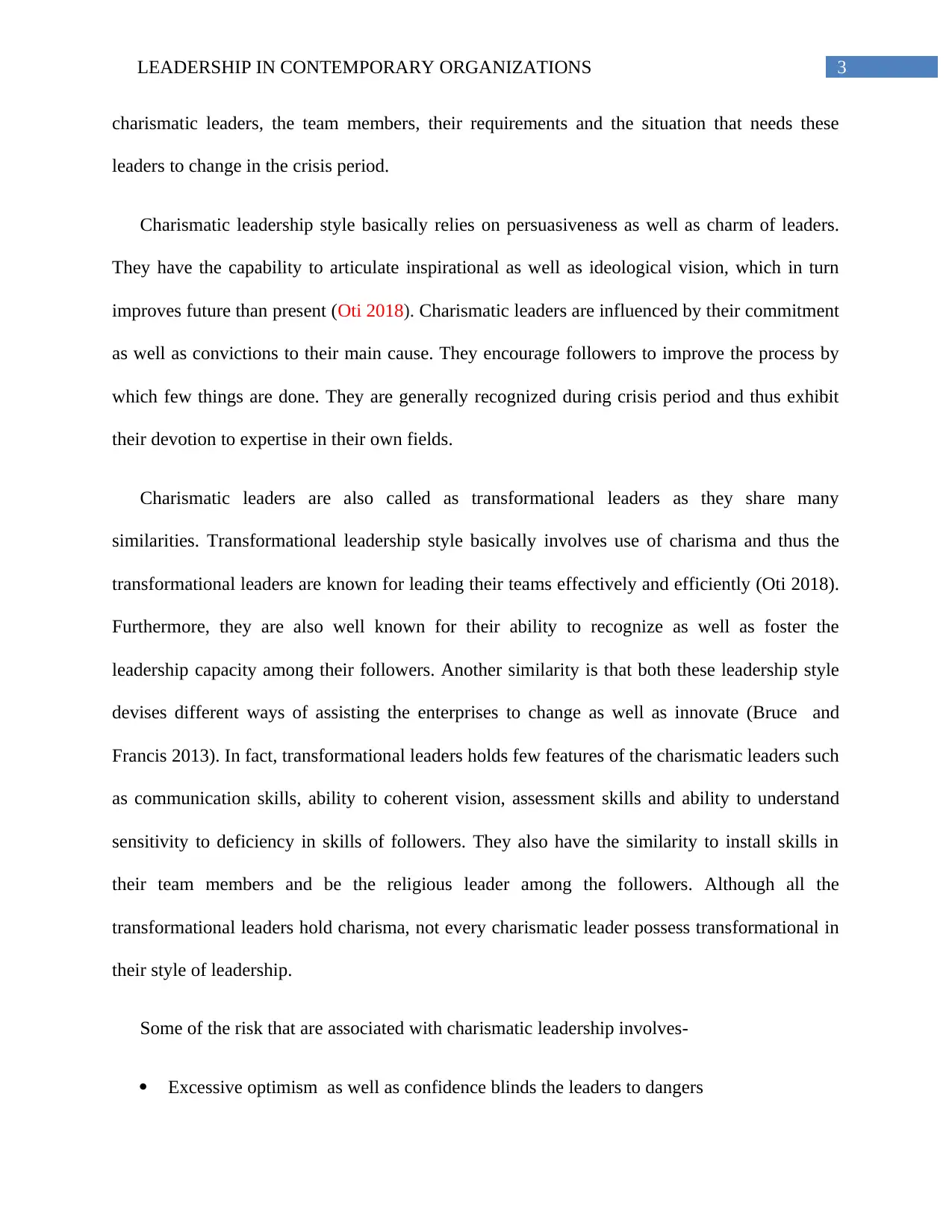
3LEADERSHIP IN CONTEMPORARY ORGANIZATIONS
charismatic leaders, the team members, their requirements and the situation that needs these
leaders to change in the crisis period.
Charismatic leadership style basically relies on persuasiveness as well as charm of leaders.
They have the capability to articulate inspirational as well as ideological vision, which in turn
improves future than present (Oti 2018). Charismatic leaders are influenced by their commitment
as well as convictions to their main cause. They encourage followers to improve the process by
which few things are done. They are generally recognized during crisis period and thus exhibit
their devotion to expertise in their own fields.
Charismatic leaders are also called as transformational leaders as they share many
similarities. Transformational leadership style basically involves use of charisma and thus the
transformational leaders are known for leading their teams effectively and efficiently (Oti 2018).
Furthermore, they are also well known for their ability to recognize as well as foster the
leadership capacity among their followers. Another similarity is that both these leadership style
devises different ways of assisting the enterprises to change as well as innovate (Bruce and
Francis 2013). In fact, transformational leaders holds few features of the charismatic leaders such
as communication skills, ability to coherent vision, assessment skills and ability to understand
sensitivity to deficiency in skills of followers. They also have the similarity to install skills in
their team members and be the religious leader among the followers. Although all the
transformational leaders hold charisma, not every charismatic leader possess transformational in
their style of leadership.
Some of the risk that are associated with charismatic leadership involves-
Excessive optimism as well as confidence blinds the leaders to dangers
charismatic leaders, the team members, their requirements and the situation that needs these
leaders to change in the crisis period.
Charismatic leadership style basically relies on persuasiveness as well as charm of leaders.
They have the capability to articulate inspirational as well as ideological vision, which in turn
improves future than present (Oti 2018). Charismatic leaders are influenced by their commitment
as well as convictions to their main cause. They encourage followers to improve the process by
which few things are done. They are generally recognized during crisis period and thus exhibit
their devotion to expertise in their own fields.
Charismatic leaders are also called as transformational leaders as they share many
similarities. Transformational leadership style basically involves use of charisma and thus the
transformational leaders are known for leading their teams effectively and efficiently (Oti 2018).
Furthermore, they are also well known for their ability to recognize as well as foster the
leadership capacity among their followers. Another similarity is that both these leadership style
devises different ways of assisting the enterprises to change as well as innovate (Bruce and
Francis 2013). In fact, transformational leaders holds few features of the charismatic leaders such
as communication skills, ability to coherent vision, assessment skills and ability to understand
sensitivity to deficiency in skills of followers. They also have the similarity to install skills in
their team members and be the religious leader among the followers. Although all the
transformational leaders hold charisma, not every charismatic leader possess transformational in
their style of leadership.
Some of the risk that are associated with charismatic leadership involves-
Excessive optimism as well as confidence blinds the leaders to dangers
Paraphrase This Document
Need a fresh take? Get an instant paraphrase of this document with our AI Paraphraser
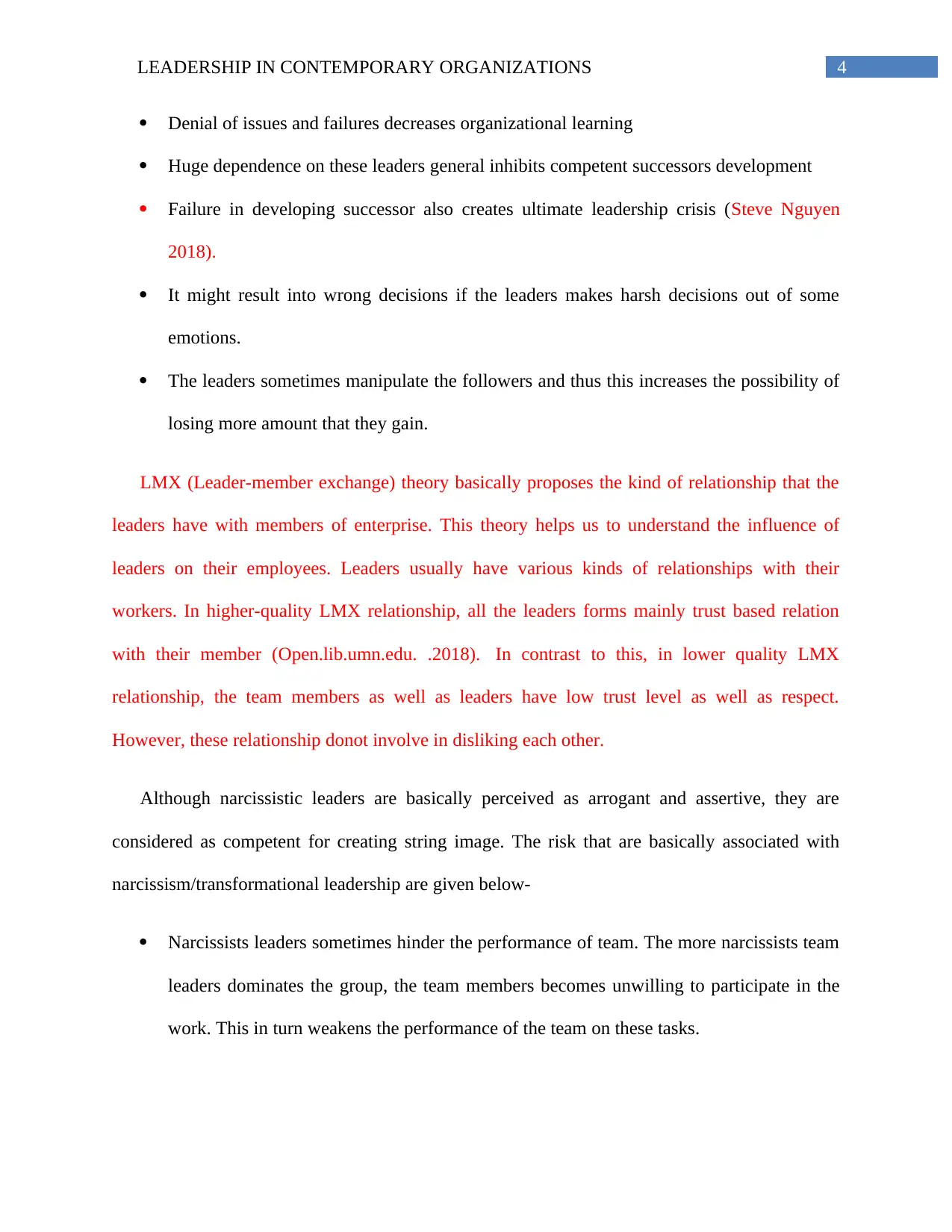
4LEADERSHIP IN CONTEMPORARY ORGANIZATIONS
Denial of issues and failures decreases organizational learning
Huge dependence on these leaders general inhibits competent successors development
Failure in developing successor also creates ultimate leadership crisis (Steve Nguyen
2018).
It might result into wrong decisions if the leaders makes harsh decisions out of some
emotions.
The leaders sometimes manipulate the followers and thus this increases the possibility of
losing more amount that they gain.
LMX (Leader-member exchange) theory basically proposes the kind of relationship that the
leaders have with members of enterprise. This theory helps us to understand the influence of
leaders on their employees. Leaders usually have various kinds of relationships with their
workers. In higher-quality LMX relationship, all the leaders forms mainly trust based relation
with their member (Open.lib.umn.edu. .2018). In contrast to this, in lower quality LMX
relationship, the team members as well as leaders have low trust level as well as respect.
However, these relationship donot involve in disliking each other.
Although narcissistic leaders are basically perceived as arrogant and assertive, they are
considered as competent for creating string image. The risk that are basically associated with
narcissism/transformational leadership are given below-
Narcissists leaders sometimes hinder the performance of team. The more narcissists team
leaders dominates the group, the team members becomes unwilling to participate in the
work. This in turn weakens the performance of the team on these tasks.
Denial of issues and failures decreases organizational learning
Huge dependence on these leaders general inhibits competent successors development
Failure in developing successor also creates ultimate leadership crisis (Steve Nguyen
2018).
It might result into wrong decisions if the leaders makes harsh decisions out of some
emotions.
The leaders sometimes manipulate the followers and thus this increases the possibility of
losing more amount that they gain.
LMX (Leader-member exchange) theory basically proposes the kind of relationship that the
leaders have with members of enterprise. This theory helps us to understand the influence of
leaders on their employees. Leaders usually have various kinds of relationships with their
workers. In higher-quality LMX relationship, all the leaders forms mainly trust based relation
with their member (Open.lib.umn.edu. .2018). In contrast to this, in lower quality LMX
relationship, the team members as well as leaders have low trust level as well as respect.
However, these relationship donot involve in disliking each other.
Although narcissistic leaders are basically perceived as arrogant and assertive, they are
considered as competent for creating string image. The risk that are basically associated with
narcissism/transformational leadership are given below-
Narcissists leaders sometimes hinder the performance of team. The more narcissists team
leaders dominates the group, the team members becomes unwilling to participate in the
work. This in turn weakens the performance of the team on these tasks.
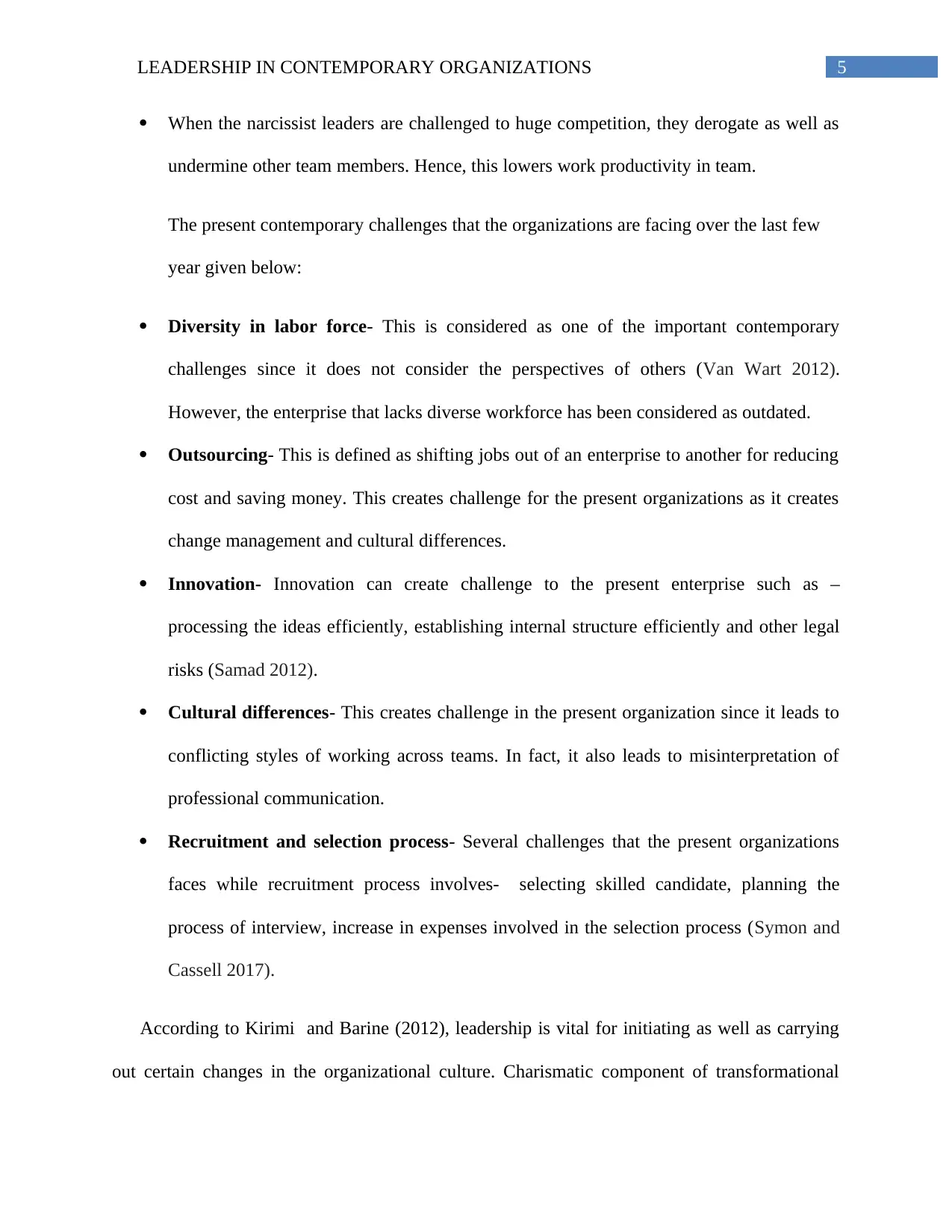
5LEADERSHIP IN CONTEMPORARY ORGANIZATIONS
When the narcissist leaders are challenged to huge competition, they derogate as well as
undermine other team members. Hence, this lowers work productivity in team.
The present contemporary challenges that the organizations are facing over the last few
year given below:
Diversity in labor force- This is considered as one of the important contemporary
challenges since it does not consider the perspectives of others (Van Wart 2012).
However, the enterprise that lacks diverse workforce has been considered as outdated.
Outsourcing- This is defined as shifting jobs out of an enterprise to another for reducing
cost and saving money. This creates challenge for the present organizations as it creates
change management and cultural differences.
Innovation- Innovation can create challenge to the present enterprise such as –
processing the ideas efficiently, establishing internal structure efficiently and other legal
risks (Samad 2012).
Cultural differences- This creates challenge in the present organization since it leads to
conflicting styles of working across teams. In fact, it also leads to misinterpretation of
professional communication.
Recruitment and selection process- Several challenges that the present organizations
faces while recruitment process involves- selecting skilled candidate, planning the
process of interview, increase in expenses involved in the selection process (Symon and
Cassell 2017).
According to Kirimi and Barine (2012), leadership is vital for initiating as well as carrying
out certain changes in the organizational culture. Charismatic component of transformational
When the narcissist leaders are challenged to huge competition, they derogate as well as
undermine other team members. Hence, this lowers work productivity in team.
The present contemporary challenges that the organizations are facing over the last few
year given below:
Diversity in labor force- This is considered as one of the important contemporary
challenges since it does not consider the perspectives of others (Van Wart 2012).
However, the enterprise that lacks diverse workforce has been considered as outdated.
Outsourcing- This is defined as shifting jobs out of an enterprise to another for reducing
cost and saving money. This creates challenge for the present organizations as it creates
change management and cultural differences.
Innovation- Innovation can create challenge to the present enterprise such as –
processing the ideas efficiently, establishing internal structure efficiently and other legal
risks (Samad 2012).
Cultural differences- This creates challenge in the present organization since it leads to
conflicting styles of working across teams. In fact, it also leads to misinterpretation of
professional communication.
Recruitment and selection process- Several challenges that the present organizations
faces while recruitment process involves- selecting skilled candidate, planning the
process of interview, increase in expenses involved in the selection process (Symon and
Cassell 2017).
According to Kirimi and Barine (2012), leadership is vital for initiating as well as carrying
out certain changes in the organizational culture. Charismatic component of transformational
⊘ This is a preview!⊘
Do you want full access?
Subscribe today to unlock all pages.

Trusted by 1+ million students worldwide
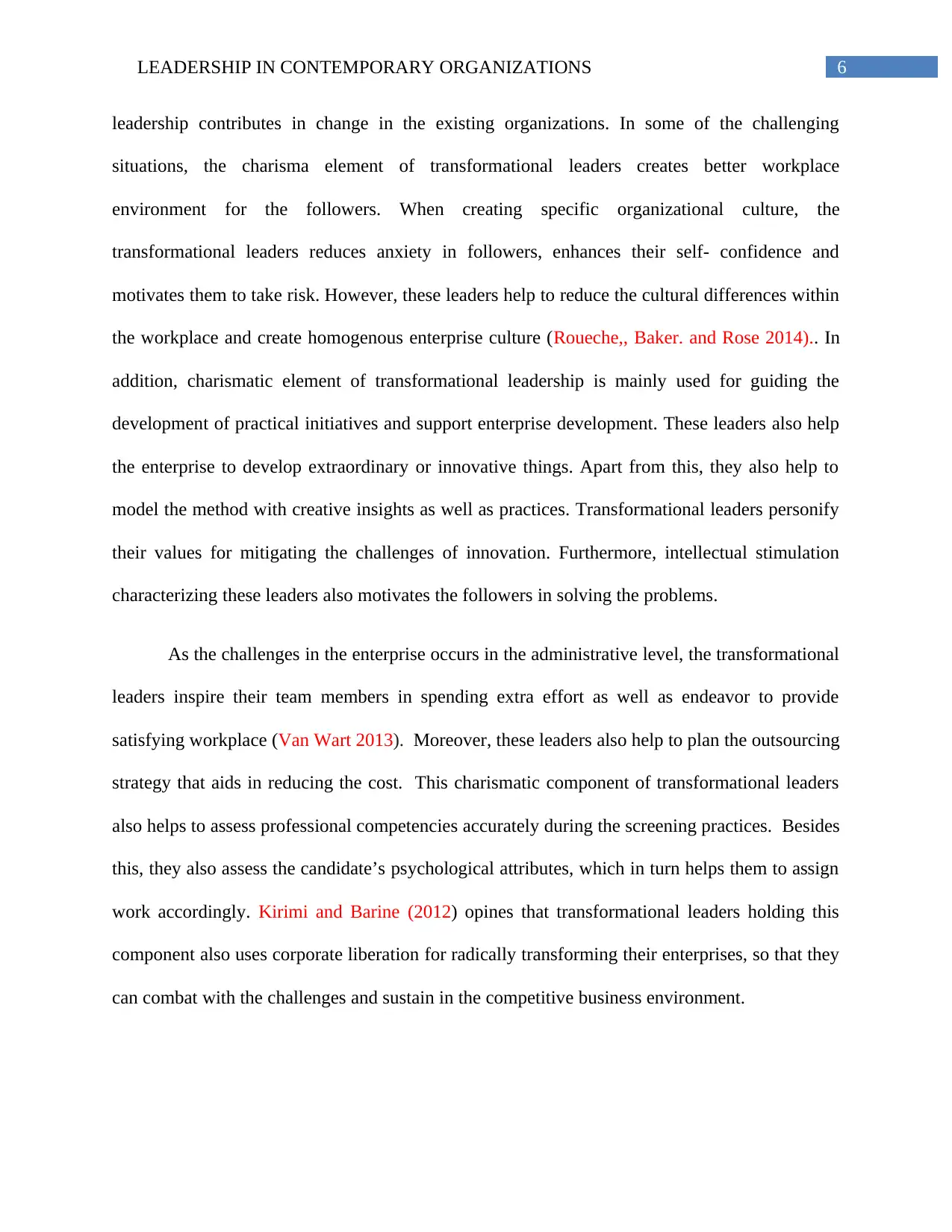
6LEADERSHIP IN CONTEMPORARY ORGANIZATIONS
leadership contributes in change in the existing organizations. In some of the challenging
situations, the charisma element of transformational leaders creates better workplace
environment for the followers. When creating specific organizational culture, the
transformational leaders reduces anxiety in followers, enhances their self- confidence and
motivates them to take risk. However, these leaders help to reduce the cultural differences within
the workplace and create homogenous enterprise culture (Roueche,, Baker. and Rose 2014).. In
addition, charismatic element of transformational leadership is mainly used for guiding the
development of practical initiatives and support enterprise development. These leaders also help
the enterprise to develop extraordinary or innovative things. Apart from this, they also help to
model the method with creative insights as well as practices. Transformational leaders personify
their values for mitigating the challenges of innovation. Furthermore, intellectual stimulation
characterizing these leaders also motivates the followers in solving the problems.
As the challenges in the enterprise occurs in the administrative level, the transformational
leaders inspire their team members in spending extra effort as well as endeavor to provide
satisfying workplace (Van Wart 2013). Moreover, these leaders also help to plan the outsourcing
strategy that aids in reducing the cost. This charismatic component of transformational leaders
also helps to assess professional competencies accurately during the screening practices. Besides
this, they also assess the candidate’s psychological attributes, which in turn helps them to assign
work accordingly. Kirimi and Barine (2012) opines that transformational leaders holding this
component also uses corporate liberation for radically transforming their enterprises, so that they
can combat with the challenges and sustain in the competitive business environment.
leadership contributes in change in the existing organizations. In some of the challenging
situations, the charisma element of transformational leaders creates better workplace
environment for the followers. When creating specific organizational culture, the
transformational leaders reduces anxiety in followers, enhances their self- confidence and
motivates them to take risk. However, these leaders help to reduce the cultural differences within
the workplace and create homogenous enterprise culture (Roueche,, Baker. and Rose 2014).. In
addition, charismatic element of transformational leadership is mainly used for guiding the
development of practical initiatives and support enterprise development. These leaders also help
the enterprise to develop extraordinary or innovative things. Apart from this, they also help to
model the method with creative insights as well as practices. Transformational leaders personify
their values for mitigating the challenges of innovation. Furthermore, intellectual stimulation
characterizing these leaders also motivates the followers in solving the problems.
As the challenges in the enterprise occurs in the administrative level, the transformational
leaders inspire their team members in spending extra effort as well as endeavor to provide
satisfying workplace (Van Wart 2013). Moreover, these leaders also help to plan the outsourcing
strategy that aids in reducing the cost. This charismatic component of transformational leaders
also helps to assess professional competencies accurately during the screening practices. Besides
this, they also assess the candidate’s psychological attributes, which in turn helps them to assign
work accordingly. Kirimi and Barine (2012) opines that transformational leaders holding this
component also uses corporate liberation for radically transforming their enterprises, so that they
can combat with the challenges and sustain in the competitive business environment.
Paraphrase This Document
Need a fresh take? Get an instant paraphrase of this document with our AI Paraphraser
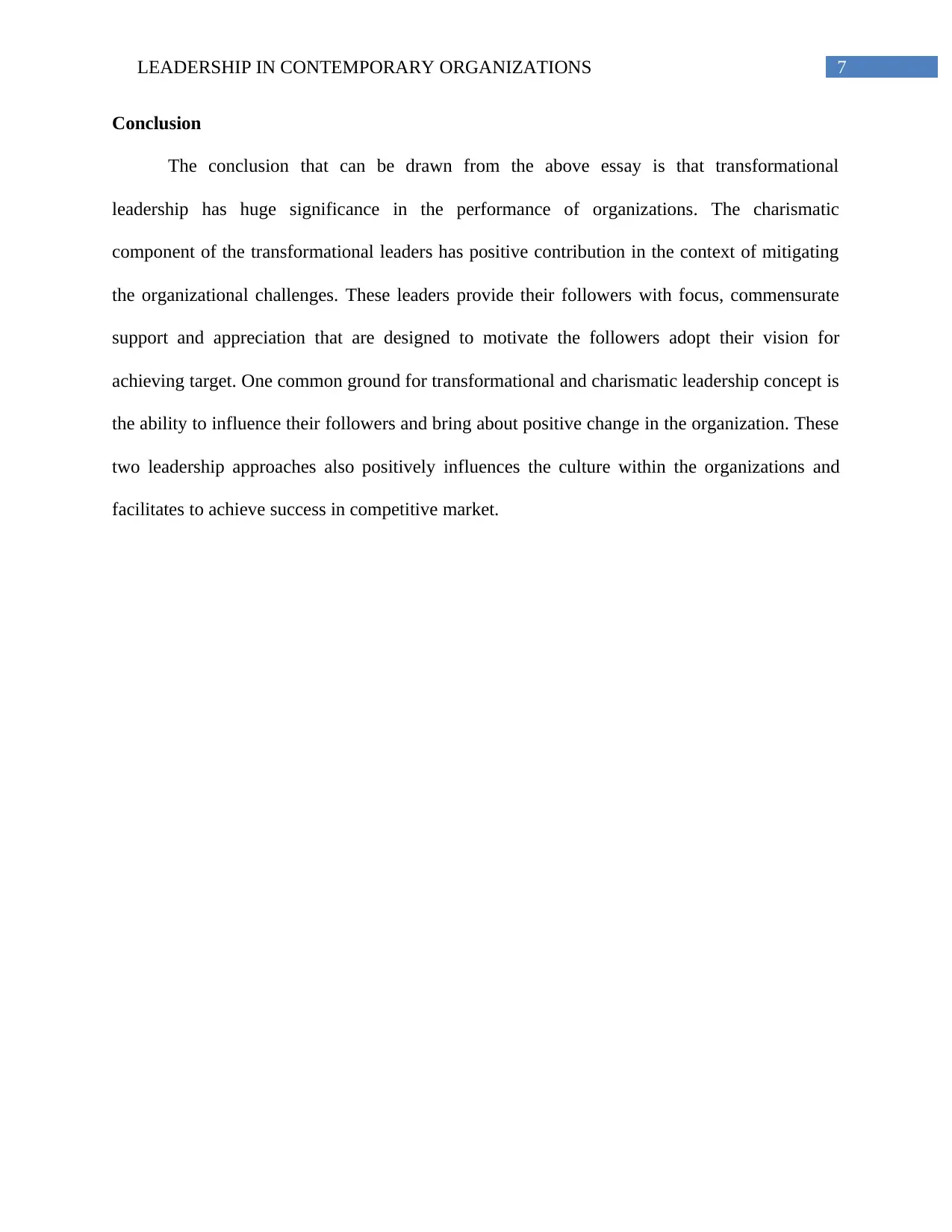
7LEADERSHIP IN CONTEMPORARY ORGANIZATIONS
Conclusion
The conclusion that can be drawn from the above essay is that transformational
leadership has huge significance in the performance of organizations. The charismatic
component of the transformational leaders has positive contribution in the context of mitigating
the organizational challenges. These leaders provide their followers with focus, commensurate
support and appreciation that are designed to motivate the followers adopt their vision for
achieving target. One common ground for transformational and charismatic leadership concept is
the ability to influence their followers and bring about positive change in the organization. These
two leadership approaches also positively influences the culture within the organizations and
facilitates to achieve success in competitive market.
Conclusion
The conclusion that can be drawn from the above essay is that transformational
leadership has huge significance in the performance of organizations. The charismatic
component of the transformational leaders has positive contribution in the context of mitigating
the organizational challenges. These leaders provide their followers with focus, commensurate
support and appreciation that are designed to motivate the followers adopt their vision for
achieving target. One common ground for transformational and charismatic leadership concept is
the ability to influence their followers and bring about positive change in the organization. These
two leadership approaches also positively influences the culture within the organizations and
facilitates to achieve success in competitive market.
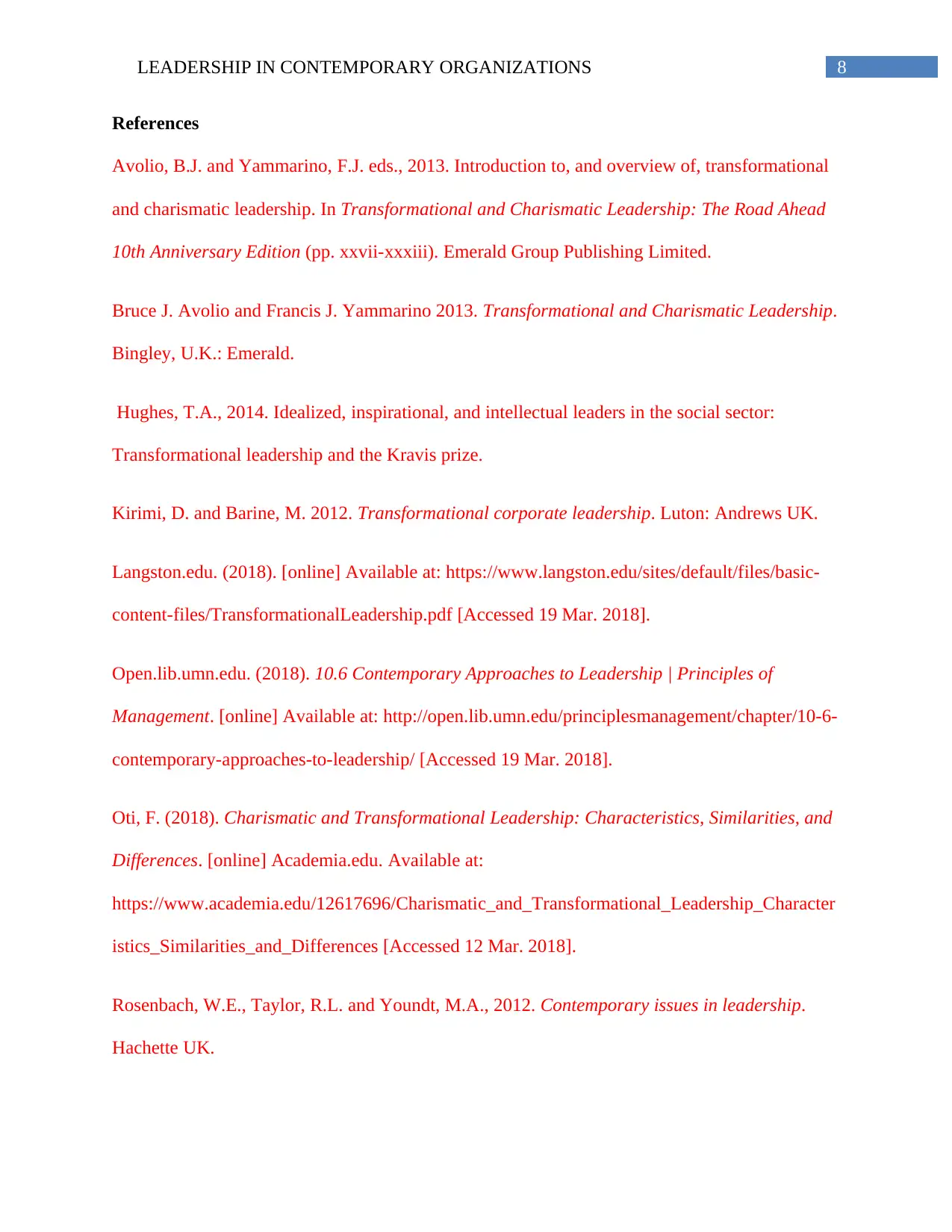
8LEADERSHIP IN CONTEMPORARY ORGANIZATIONS
References
Avolio, B.J. and Yammarino, F.J. eds., 2013. Introduction to, and overview of, transformational
and charismatic leadership. In Transformational and Charismatic Leadership: The Road Ahead
10th Anniversary Edition (pp. xxvii-xxxiii). Emerald Group Publishing Limited.
Bruce J. Avolio and Francis J. Yammarino 2013. Transformational and Charismatic Leadership.
Bingley, U.K.: Emerald.
Hughes, T.A., 2014. Idealized, inspirational, and intellectual leaders in the social sector:
Transformational leadership and the Kravis prize.
Kirimi, D. and Barine, M. 2012. Transformational corporate leadership. Luton: Andrews UK.
Langston.edu. (2018). [online] Available at: https://www.langston.edu/sites/default/files/basic-
content-files/TransformationalLeadership.pdf [Accessed 19 Mar. 2018].
Open.lib.umn.edu. (2018). 10.6 Contemporary Approaches to Leadership | Principles of
Management. [online] Available at: http://open.lib.umn.edu/principlesmanagement/chapter/10-6-
contemporary-approaches-to-leadership/ [Accessed 19 Mar. 2018].
Oti, F. (2018). Charismatic and Transformational Leadership: Characteristics, Similarities, and
Differences. [online] Academia.edu. Available at:
https://www.academia.edu/12617696/Charismatic_and_Transformational_Leadership_Character
istics_Similarities_and_Differences [Accessed 12 Mar. 2018].
Rosenbach, W.E., Taylor, R.L. and Youndt, M.A., 2012. Contemporary issues in leadership.
Hachette UK.
References
Avolio, B.J. and Yammarino, F.J. eds., 2013. Introduction to, and overview of, transformational
and charismatic leadership. In Transformational and Charismatic Leadership: The Road Ahead
10th Anniversary Edition (pp. xxvii-xxxiii). Emerald Group Publishing Limited.
Bruce J. Avolio and Francis J. Yammarino 2013. Transformational and Charismatic Leadership.
Bingley, U.K.: Emerald.
Hughes, T.A., 2014. Idealized, inspirational, and intellectual leaders in the social sector:
Transformational leadership and the Kravis prize.
Kirimi, D. and Barine, M. 2012. Transformational corporate leadership. Luton: Andrews UK.
Langston.edu. (2018). [online] Available at: https://www.langston.edu/sites/default/files/basic-
content-files/TransformationalLeadership.pdf [Accessed 19 Mar. 2018].
Open.lib.umn.edu. (2018). 10.6 Contemporary Approaches to Leadership | Principles of
Management. [online] Available at: http://open.lib.umn.edu/principlesmanagement/chapter/10-6-
contemporary-approaches-to-leadership/ [Accessed 19 Mar. 2018].
Oti, F. (2018). Charismatic and Transformational Leadership: Characteristics, Similarities, and
Differences. [online] Academia.edu. Available at:
https://www.academia.edu/12617696/Charismatic_and_Transformational_Leadership_Character
istics_Similarities_and_Differences [Accessed 12 Mar. 2018].
Rosenbach, W.E., Taylor, R.L. and Youndt, M.A., 2012. Contemporary issues in leadership.
Hachette UK.
⊘ This is a preview!⊘
Do you want full access?
Subscribe today to unlock all pages.

Trusted by 1+ million students worldwide
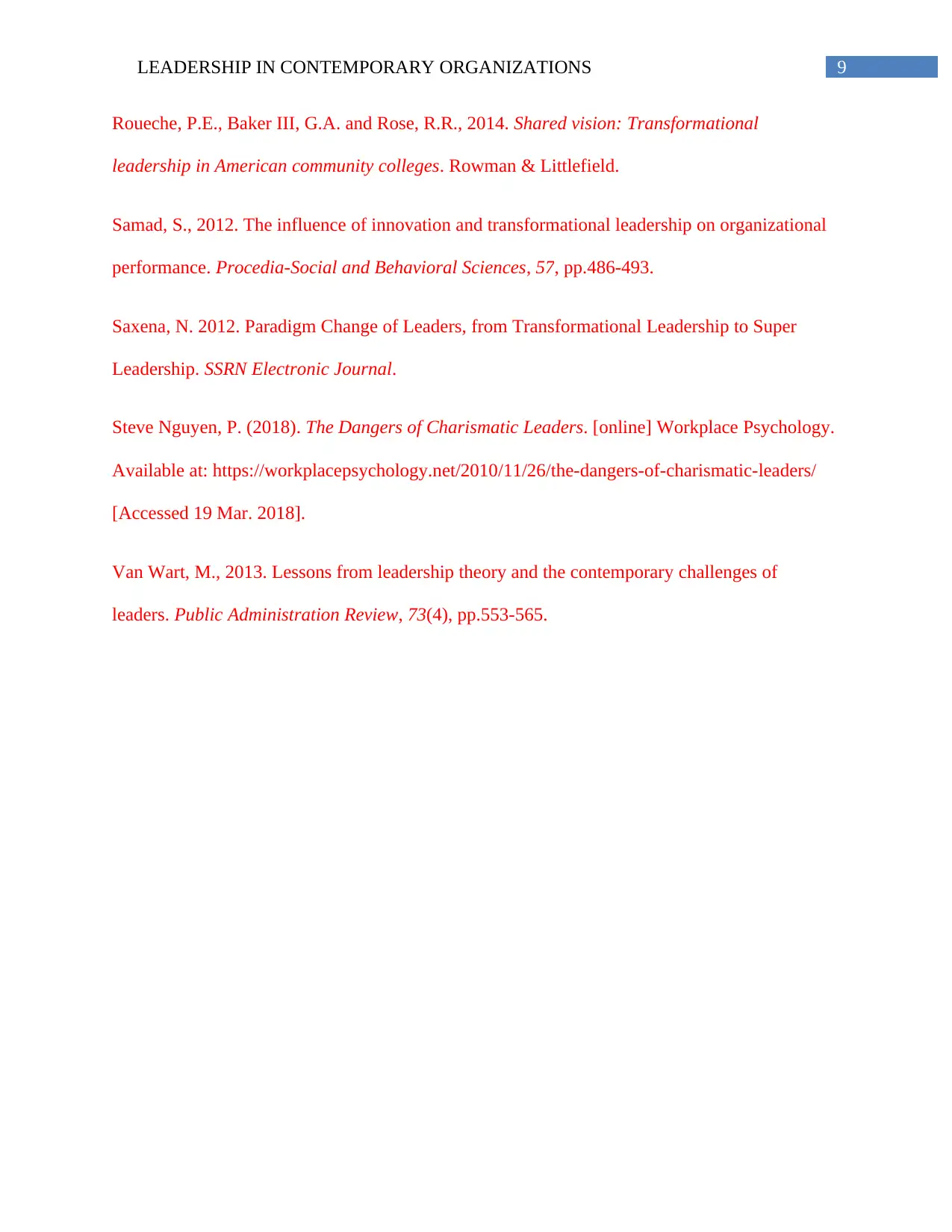
9LEADERSHIP IN CONTEMPORARY ORGANIZATIONS
Roueche, P.E., Baker III, G.A. and Rose, R.R., 2014. Shared vision: Transformational
leadership in American community colleges. Rowman & Littlefield.
Samad, S., 2012. The influence of innovation and transformational leadership on organizational
performance. Procedia-Social and Behavioral Sciences, 57, pp.486-493.
Saxena, N. 2012. Paradigm Change of Leaders, from Transformational Leadership to Super
Leadership. SSRN Electronic Journal.
Steve Nguyen, P. (2018). The Dangers of Charismatic Leaders. [online] Workplace Psychology.
Available at: https://workplacepsychology.net/2010/11/26/the-dangers-of-charismatic-leaders/
[Accessed 19 Mar. 2018].
Van Wart, M., 2013. Lessons from leadership theory and the contemporary challenges of
leaders. Public Administration Review, 73(4), pp.553-565.
Roueche, P.E., Baker III, G.A. and Rose, R.R., 2014. Shared vision: Transformational
leadership in American community colleges. Rowman & Littlefield.
Samad, S., 2012. The influence of innovation and transformational leadership on organizational
performance. Procedia-Social and Behavioral Sciences, 57, pp.486-493.
Saxena, N. 2012. Paradigm Change of Leaders, from Transformational Leadership to Super
Leadership. SSRN Electronic Journal.
Steve Nguyen, P. (2018). The Dangers of Charismatic Leaders. [online] Workplace Psychology.
Available at: https://workplacepsychology.net/2010/11/26/the-dangers-of-charismatic-leaders/
[Accessed 19 Mar. 2018].
Van Wart, M., 2013. Lessons from leadership theory and the contemporary challenges of
leaders. Public Administration Review, 73(4), pp.553-565.
1 out of 10
Related Documents
Your All-in-One AI-Powered Toolkit for Academic Success.
+13062052269
info@desklib.com
Available 24*7 on WhatsApp / Email
![[object Object]](/_next/static/media/star-bottom.7253800d.svg)
Unlock your academic potential
Copyright © 2020–2025 A2Z Services. All Rights Reserved. Developed and managed by ZUCOL.




